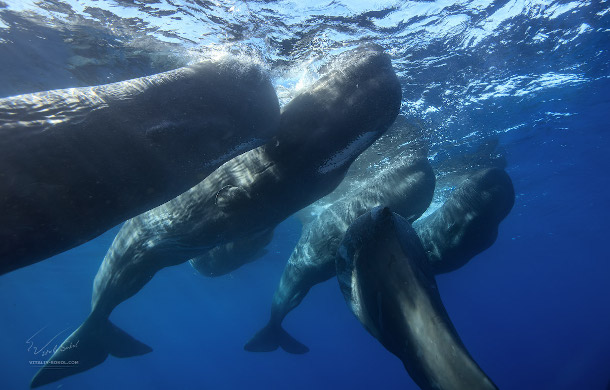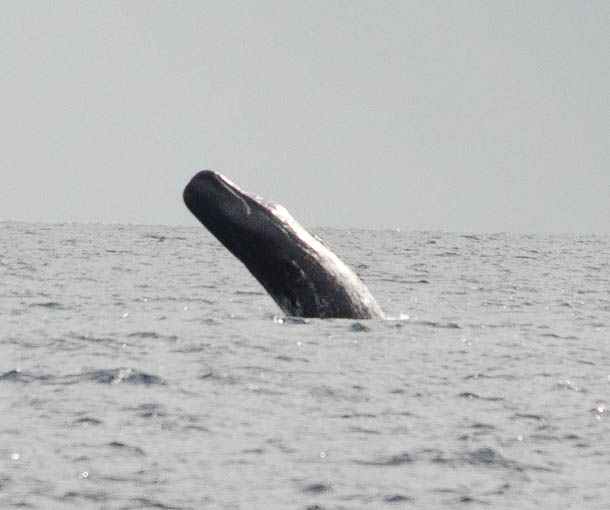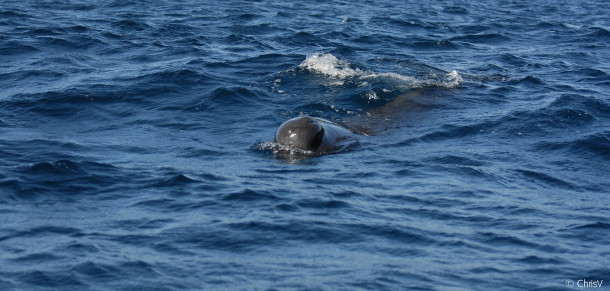‘Becoming Wild’ and Culture Among Animals
Air Date: Week of January 29, 2021

A pod of sperm whales socializing. The whales are known to be highly social and tend to travel in groups. (Photo: Will Falcon, Wikimedia Commons, CC BY 4.0)
‘Becoming Wild’ and Culture Among Animals: For people culture is characterized by things like language, food, and customs, and biologists are finding the same is true for many animal species. In his latest book, Becoming Wild, Carl Safina explores how a variety of animals, from sperm whales to birds, live within a culture, in much the same way as humans. Carl Safina talks with Host Steve Curwood.
Transcript
CURWOOD: For people culture is characterized by language, food, customs, certain territories and a shared sense of esthetics. And biologists are now paying more attention the concept of culture in the animal world. Carl Safina’s latest book is called Becoming Wild: How Animal Cultures Raise Families, Create Beauty and Achieve Peace. In this book he writes about how animals from whales to birds live their lives within cultures with language, food and customs that define them in ways similar to how cultures define us. Becoming Wild is Carl Safina’s tenth book, and he joins me now. Welcome back to Living on Earth, Carl!
SAFINA: Well, thank you.
CURWOOD: So Carl, what is culture?
SAFINA: Culture is the behaviors, the habits, and even the attractions that we learn socially and that are transmitted socially. The amazing thing to me is that, whether it's human, modern, Western technological culture, or whether it's sperm whales, culture basically does the same things for social beings. It answers the question of, how do we live here, where we live?
CURWOOD: So I think what's so fascinating about this book, and maybe this is the point. Animals have culture. I mean, you've been talking in your previous works about consciousness that animals have, but here, you have picked some examples to show that animals have culture. Why do that?
SAFINA: I'm trying to figure out who we are by by knowing who we're with. And that informs everything about life. You know, it gives us perspective. Where do we come from? How are we compared to other living things? What are the overlaps? What are the similarities? And I find it both intellectually fascinating, also, emotionally astonishing, and, and very beautiful a lot of the time.
CURWOOD: What animals have things like, say favorite baseball teams, and, and music and whether or not maybe they were Michael Jordan's, or wingtips? What do we see of that in the world of animal culture that you studied doing this work?

A mother and calf sperm whale off the coast of Mauritius. The rest of the pod swims close by. (Photo: Gabriel Barathieu, Wikimedia Commons, CC BY-SA 2.0)
SAFINA: You just fell right into the gigantic pit trap of how to approach this subject, which is to take the human answer sheet and see how other animals score on our test. If we like certain kinds of shoes, you know, that's part of our culture. But with other animals, it's things like, what constitutes food for us in this region? Where do we go in the winter, when things start to get harsh? What predators do we need to be aware of and be afraid of? And because the things that you were talking about specific kinds of shoes or specific teams and things like that, those are ways that humans specialize within their culture. This is a major aspect of culture, across all species, is that culture is really based on specialized ways of doing things. And those specialized ways vary from one cultural group to the next. So, for instance, you have sperm whale clans, that one clan hunts and travels in a certain pattern. Another clan that may swim through the same waters, they hunt and travel with a different pattern. Chimpanzees, you probably know that chimpanzees make tools out of sticks and things like that. But there are chimpanzees that make no tools out of sticks. There are chimpanzees that use stone tools. There are a lot of different kinds of things within chimpanzee cultures, but they vary from place to place, which is one of the main reasons that we know that it's cultural. Birds often sing with a local dialect. If you move them to a different place, and they start trying to court using the dialect from where they're from. Well, that is not the favorite song of the place that you've just experimentally moved them to. And their courtship will not find any engagement among the females there who are listening and looking for suitable males. It's a weird song to them. So you know, humans have a kind of similar thing. We listen to music from other cultures, we tend to like our own the most. We identify with our own the most. And, so the details are really totally different. But how it functions is really remarkably similar.
CURWOOD: So you open your book down off of Dominica in the Caribbean, I guess what's really cool about that area is that these are volcanic mountains that really just erupt from the ocean floor. How many feet down, would you say Carl?
SAFINA: Oh, I really don't know exactly how far they plunge but very, very close to shore, within just two or three miles. It's several thousand feet deep. And that's why we were there because sperm whales live in very deep ocean, but there, you can study them from shore because a few miles from shore, you're in very deep ocean.

A sperm whale spotted in Kaikoura, a town in the southern island of New Zealand. The whales can be spotted in all deep oceans, such as the one off of Kaikoura. (Photo: Gregory Smith, Flickr, CC BY-SA 2.0)
CURWOOD: And so you spent a fair amount of time studying sperm whales, and you talk about them in terms of having a culture. What are the elements of that culture and and how do they communicate?
SAFINA: Basically, one of the most surprising things about sperm whales is that their social organization is almost exactly like elephants. They live in female-led families where the matriarch, the oldest female, she may be with her younger sisters and their daughters and their children. When the males get to adolescence, just like with elephants, they go off they have a different male kind of a social structure. But these family groups are female. And why is that? It's similar reasons in both situations is that they have need to protect very helpless babies as a group. With the sperm whales, their food is maybe 3000 feet from the surface. There's no light at all. There's very cold temperatures, they hunt entirely by using sonar. They make these clicks about every other, about two per second. And they hunt for squid that way in the dark using sonar, and they're down for about 15 minutes at a time. And then they come up for about 10 or 12 minutes. The babies cannot go down there. And left at the surface, they're totally helpless. So if any orcas killer whales show up, or any, sometimes pilot whales or, or false killer whales like to harass them, they're totally helpless. So they need somebody to keep an eye on them. And that would be if if their mother is down looking for food, one of their aunts or possibly an older sister would be babysitting for them. At the slightest sign of any trouble, she will call and they will all come rocketing up from the depths. As somebody said, when there's any trouble, sperm will seem to come out of nowhere. And they call other groups of sperm whales that may come from as far as seven miles away, coming toward the danger, looking as a group to protect the most vulnerable and to protect each other from dangerous attack. They communicate with clicks. And when they're hunting. The clicks are, as I said, about two per second. When they're at the surface or coming near the surface, they change these two patterns of cliques that sound like simple Morse code. And in fact, they're called codas by the scientists. And what they say at the very minimum, maybe they say some other things, but at the very minimum, they say who they are as an individual. They announce who they are. They announce what family they are with. And they announce what clan their family belongs to. Families within a clan can socialize. But families of different clans avoid one another. So that's how they say it and that's what they say.

A sperm whale and giant squid locked together. The whale can grow up to 59 feet and the largest giant squid was recorded to be 43 feet. (Photo: Ryan Somma, Flickr, CC BY-SA 2.0)
CURWOOD: So if the sperm whales live together in a tight culture just in their family group, certainly no, no wider circle than their clan. What happens to genetic diversity for them?
SAFINA: Well, sperm whale clans are big. They may contain thousands of whales. And with the sperm whales, what happens is the males leave. And they go for a number of years to high latitudes, while the females stay mostly in the tropics and subtropics the males go to places that can be very cold. And then they come down, and they look for groups of females and they mate. So the males keep the gene pool mixed. And that's why the sperm whale culture is purely cultural, has no genetic component. But the Orca whales, for instance, they have fish eating groupsand mammal eating groups. They do not have roaming males. Their males stay within what's called their community, which is kind of like a smaller, much smaller clan that may have a few hundred individuals and the males will not leave that community. And that's why with them, you do get genetic differentiation so that the fish eating ones are a little different than the mammal eating ones in terms of the size of their teeth and the strength of their jaws. After you have this culture of catching mammals, there is a pressure for your genes to catch up and give you bigger teeth, bigger jaws, stronger jaws, and that is exactly what we see. And the other thing that we see is that those two types have not interbred for several 100,000 years. The usual definition of species is you can interbreed freely when you meet an individual of your own species. They don't do that. So the culture has made them segregate and start evolving into a deeper specialization, each of them, that has gotten them along a different evolutionary path. And this is the kind of effect of culture that I think has been totally overlooked. Until basically until now. With Orca whales around the world. There are probably ten different, what they call them types. But when the genetic evaluations are all done, I think we will find that they really are different species because they are genetically differentiated as a result of this cultural divergence and self-segregation. One scientist said that Orca whales are the most self-segregated species other than humans.
CURWOOD: So, in all this work, studying sperm whales, that sounds like a challenging environment where if you're offshore, it's several thousand feet down. What sort of intelligence did you observe in these whales? What surprised you?

A sperm whale breaching. This species is the largest of the toothed whales. (Photo: Neil DeMaster, Flickr, CC BY-NC-ND 2.0)
SAFINA: I think what surprised me was how very mammalian they are. You know, they don't have hands. They don't have any rear appendage at all. They have front flippers, they have this gigantic head that's a third of their body length, which is a sound amplifying boombox. It makes, it makes them able to emit the loudest sound made by any living thing. So they're very odd looking compared to us. They have, you know, they have basically a fish shape. They live in the ocean. But when they get together, they're very mammalian. They like caressing each other. They extend their flippers and rub their flippers along each other. They roll around together. They appear to be very happy to be together when they get together, which is you know. As I said, usually they go down for most of an hour, and then they come back they meet whoever is babysitting the young one. And it's a greeting time and sometimes they just chill and they seem relaxed. They seem pleased to be with one another. And they seem excited to rejoin one another. As they're coming up these codas intensify. One scientist witnessed a birth and said that, at the moment of birth, there was a loud blast of codas from the other whales that were present for the birth. So I think that was the most surprising thing about them.
CURWOOD: I'm just wondering, Carl, if you'd be willing to share a reading, starting from that last full paragraph of page 272 of your, of your book.
SAFINA: When we stop viewing the apes and parrots and dolphins as quote, models of primitive human origins. When we remove our human blinders, we can see that other beings on Earth take an interest in their lives and understand something about who they are, where they are, who they're with, and what they're doing. In their shared experience, they sow and reap their own cultures. Who we are voyaging with on this lonely living planet is quite possibly the only meaningful line of inquiry.

A baby sperm whale approaching a boat. (Photo: Christine Veeschkens, Flickr, CC BY-NC-ND 2.0)
CURWOOD: Carl Safina is the author of "Becoming Wild: How Animal Cultures Raise Families, Create Beauty, and Achieve Peace." Carl, thanks so much for taking the time to join us today.
SAFINA: I'm always very honored to be with you. It's been really great and really fun.
Links
Living on Earth wants to hear from you!
Living on Earth
62 Calef Highway, Suite 212
Lee, NH 03861
Telephone: 617-287-4121
E-mail: comments@loe.org
Newsletter [Click here]
Donate to Living on Earth!
Living on Earth is an independent media program and relies entirely on contributions from listeners and institutions supporting public service. Please donate now to preserve an independent environmental voice.
NewsletterLiving on Earth offers a weekly delivery of the show's rundown to your mailbox. Sign up for our newsletter today!
 Sailors For The Sea: Be the change you want to sea.
Sailors For The Sea: Be the change you want to sea.
 The Grantham Foundation for the Protection of the Environment: Committed to protecting and improving the health of the global environment.
The Grantham Foundation for the Protection of the Environment: Committed to protecting and improving the health of the global environment.
 Contribute to Living on Earth and receive, as our gift to you, an archival print of one of Mark Seth Lender's extraordinary wildlife photographs. Follow the link to see Mark's current collection of photographs.
Contribute to Living on Earth and receive, as our gift to you, an archival print of one of Mark Seth Lender's extraordinary wildlife photographs. Follow the link to see Mark's current collection of photographs.
 Buy a signed copy of Mark Seth Lender's book Smeagull the Seagull & support Living on Earth
Buy a signed copy of Mark Seth Lender's book Smeagull the Seagull & support Living on Earth

